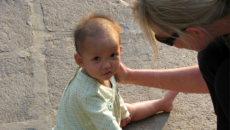When a child is placed into a new family, his world changes radically. Some children make this transition smoothly, but many do not. An adjustment period is to be expected, and rough patches do not imply that the child is rejecting his new home. A child may have frequent tantrums, crying on and off for days. Some, like my eldest daughter, withdraw, sleeping excessively.
As long as parents know that some difficulties are entirely normal, two guiding principles will help to ease adjustment for your newly adopted child. First, introduce change as gradually as possible whenever it’s within your control. A new family and a new home are big enough changes for a young child to cope with; stick with familiar scents, foods, and routines as long as possible.
Second, provide care and comfort as consistently as possible, and your child will soon learn that he can depend on you to meet his needs. With that trust, will come attachment. Here are several specific strategies parents can use from day one to ease a child’s transition into family life.
The First Meeting. Most parents cannot wait to hold their newly adopted child. It will be hard, but give him some time to “get to know you” first. It may be better to let him size you up while a familiar caregiver holds him. Take your time before reaching for him, and recognize that he’s probably frightened or overwhelmed by what is happening.
Parents are often tempted to change their child out of his clothes and give him a bath as soon as they return to the hotel room, but this may not be the best thing. Again, you should give him time to get used to being around you. After you do change his clothes, avoid washing them for a few days. If he has trouble sleeping, it may help to put the clothes back into his crib or under his bedding, so he’ll be comforted by a familiar smell.
Feeding. If your child’s previous diet lacked adequate nourishment, meeting his nutritional needs will be vital. But don’t forget that emotional needs go hand-in-hand with feeding. If possible, obtain the baby formula your child used and continue it, at least for a short time.
Even if your child is considered a little old for bottle-feeding by U.S. standards, you can let him feed from a bottle while he adjusts to his new home. Pediatricians discourage prolonged bottle use because it can damage a child’s teeth, but you can minimize this danger by giving him a bottle only during family mealtimes, or only when you’re holding him. Whenever possible, cuddle up during mealtimes, so your child will come to associate the warmth of your body with food and nurturing.
Sleeping. Even if your child seems to be coping well during the day, don’t be surprised if he seeks extra comfort at night. It’s common for newly adopted children to have trouble falling asleep, to be afraid of the dark or of being alone, or to experience nightmares. If your child seems distressed at bedtime, find ways to let him know that he is not alone.
You can move a crib (or a sleeping bag, for older children) into your room, or you can sleep on a bed or cot in your child’s room. Either way, your child will be able to hear you breathing if he wakes up, and he can easily call for comfort. If you’re open to the idea of a family bed, many parents let a new child sleep with them until he feels secure in his new family. It may also help to give your child the shirt you wore during the day to cuddle with, as the feel and smell of the fabric may comfort him.
Whatever sleeping arrangement you decide is right for your family, it is not appropriate to let a newly adopted child “cry it out” as he falls asleep or when he wakes up at night. When your child understands that he is not alone, and that you’re there for him throughout the night, as well as during the day, he’ll learn to trust you.
Routines. If your child spent time in an orphanage, he’s probably used to a regimented schedule. Although you do not have to adhere to the same feeding and sleeping times that your child lived with before his adoption, establishing and sticking to a predictable routine in your home will help him understand the rhythm of his new life. Friends and family will be eager to meet your newest addition, but hold back on visits.
Limit visitors to one or two at a time, and spend the time at home, to allow him to become used to the sights, sounds, and smells of the place where he now lives. Even a trip to the grocery store may overwhelm him during the first few weeks. Definitely postpone the trip to Disney World — you’ll have the rest of his childhood to take him to this and many other over-stimulating places!
Your Needs. Spending a certain amount of time alone with your new immediate family will help ease your own transition period, as well as your child’s.



